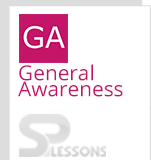 Introduction
Introduction
What is Quantitative Aptitude test?
Quantitative Aptitude is one of the prominent competitive aptitude subjects which evaluates numerical ability and problem solving skills of candidates. This test forms the major part of a number of important entrance and recruitment exams for different fields. The Quantitative Aptitude section primarily has questions related to the Simplification, Numbering Series, and Compound Interest, etc.
A candidate with quantitative aptitude knowledge will be in a better position to analyse and make sense of the given data. Quantitative Aptitude knowledge is an important measure for a prospective business executive's abilities.
The article SSC CPO Quantitative Aptitude Quiz 15 provides Quantitative Aptitude questions with answers useful to the candidates preparing for Competitive exams, Entrance exams, Interviews etc. The article SSC CPO Quantitative Aptitude Quiz 15 will assist the students to know the expected questions from Quantitative Aptitude.
 Quiz
Quiz
.1. Four friends (A, B, C and D) started a business in partnership by investing capitals in the proportion 3 : 5 : 4 : 6. During the period of one-year, these capitals were utilized in the proportion of 6 : 4 : 5 : 3 respectively. If, at the end of the year, a profit of Rs. 15,550 was made, what will be the share of D?
- A. Rs. 3250.5
B. Rs. 3750
C. Rs. 4062.59
D. Rs. 3682.89
- A. 25 kmph.
B. 32 kmph
C. 44 kmph
D. 58 kmph
- A. 5% p.a.
B. 7.5% p.a.
C. 10% p.a.
D. 12.5% p.a.
- A. Rs. 5000
B. Rs. 4570
C. Rs. 2750
D. Rs. 2950
- A. 7 : 4
B. 5 : 3
C. 2: 1
D. 7: 6
1. The length and breadth of a rectangular floor are 16.25 metre and 12.75 metre respectively. Find how many minimum number of square tiles would be required to cover it completely?
- A. 375
B. 2570
C. 2800
D. 3315
- A. Rs. 8400
B. Rs. 10,500
C. Rs. 13,600
D. Rs. 14,700
- A. 2 hours
B. 2.4 hours
C. 3 hours
D. 3.5 hours
- A. 100 m
B. 255 m
C. 375 m
D. Cannot be determined
- A. 9.8 sec
B. 11.26 sec
C. 12.42 sec
D. 14.3 sec
1. A boat running downstream covers a distance of 20 km in 2 hours while for covering the same distance upstream, it takes 5 hours. What is the speed of the boat in still water?
- A. 4 km / hr
B. 7 km / hr
C. 8 km / hr
D. Data Inadequate
- A. 35
B. 48
C. 52
D. 58
- A. 200 gm
B. 100 gm
C. 90 gm
D. 50 gm
- A. 5.4
B. 0.54
C. 0.054
D. 54
- 3
B. 7
C. 8
D. 11



